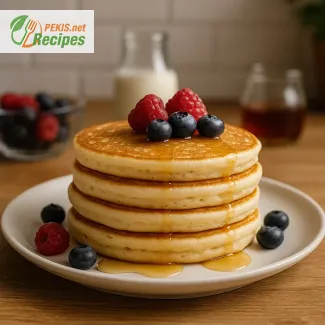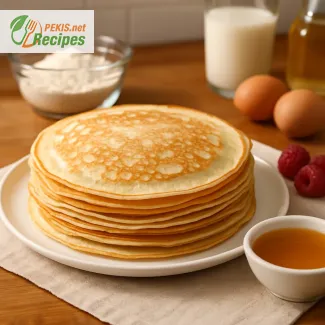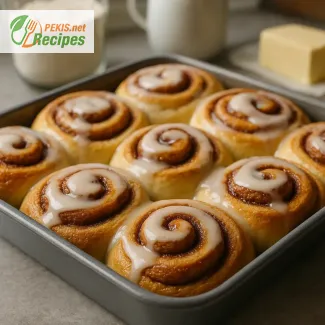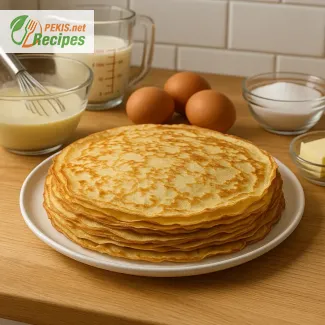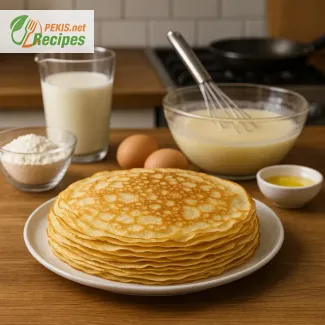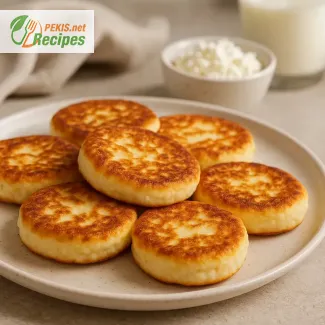
Fluffy American Pancakes stand as a symbol of comfort, indulgence, and sheer breakfast delight, gracing tables worldwide with their soft, pillowy texture and rich, buttery flavor. These iconic pancakes, characterized by their height and lightness, are a departure from thinner European-style crepes, bringing a new level of satisfaction to the breakfast table. Often topped with a generous pour of golden maple syrup, these pancakes are not only a morning staple but a versatile treat that adapts to various toppings, fillings, and flavors, making them a popular choice for any time of the day.
The Essence of Fluffy American Pancakes
Unlike other pancake varieties, American pancakes achieve their unique fluffiness and lightness through a combination of baking powder, which provides lift, and whisked eggs that add volume and softness. The batter’s thickness is a defining feature; it holds its shape when poured into the pan, allowing the pancakes to cook evenly and rise beautifully. This texture is achieved through a careful balance of flour, milk, eggs, and a hint of butter, which adds both flavor and moisture.
Culinary Uses and Versatility
Though traditionally served at breakfast, fluffy American pancakes have expanded their role on the menu to become a versatile dish that can be customized and enjoyed at any meal. Here are some popular ways they are enjoyed:
- Classic Breakfast Delight: Served with butter and pure maple syrup, this timeless pairing highlights the pancakes’ natural flavor, adding a rich sweetness that complements their light texture.
- Fruit Toppings: Fresh berries, sliced bananas, or caramelized apples offer a fresh, juicy contrast to the soft pancakes, while fruit compotes or jams introduce extra sweetness and depth.
- Savory Additions: Increasingly, American pancakes are reimagined with savory ingredients such as bacon, chives, or even smoked salmon. A drizzle of honey or hot sauce provides an adventurous twist, blending sweet and savory for a unique flavor experience.
- Chocolate and Nut Spreads: Nut butters, Nutella, or chocolate chips can be added to the batter or served as a topping, creating a decadent, dessert-like pancake that’s perfect for those with a sweet tooth.
- Yogurt and Nuts: Greek yogurt and nuts like almonds or pecans provide a creamy and crunchy contrast to the softness of the pancake, while adding nutritional value.
Varieties of American Pancakes
While the classic fluffy version remains popular, American pancakes have evolved into numerous varieties, each with its own unique twist and fan base:
- Buttermilk Pancakes: Known for their extra tang and tenderness, buttermilk pancakes are a popular variation. The acidity in buttermilk reacts with the baking powder, enhancing the pancakes’ rise and creating a slight tartness that complements the sweetness of syrup or fruit.
- Whole Wheat or Multigrain Pancakes: Healthier alternatives, these pancakes are made with whole wheat flour or a blend of grains, such as oats or buckwheat. They offer a heartier texture and more robust flavor, appealing to those seeking a nutritious breakfast option.
- Vegan Pancakes: Using ingredients like almond milk, coconut oil, and flaxseeds, vegan pancakes retain the fluffy texture of traditional pancakes without dairy or eggs, appealing to plant-based eaters.
- Gluten-Free Pancakes: Crafted with alternative flours such as almond flour, rice flour, or oat flour, gluten-free pancakes are ideal for those with dietary restrictions, providing a lighter, more delicate pancake that still achieves a lovely rise.
- Protein Pancakes: Often incorporating protein powder, cottage cheese, or Greek yogurt, these pancakes are designed for those wanting a high-protein breakfast, ideal for post-workout meals or keeping hunger at bay throughout the day.
- Silver Dollar Pancakes: Smaller in size and often served as a stack, silver dollar pancakes are a playful twist on the classic. Their miniature size makes them ideal for kids or for creating a unique presentation, whether stacked high or arranged decoratively.
The Perfect Companion: Maple Syrup
No description of fluffy American pancakes is complete without mentioning maple syrup. This naturally sweet, golden liquid is produced from the sap of maple trees, primarily in North America, where it has been a staple for centuries. Maple syrup’s caramel-like flavor and smooth texture make it the ideal topping for pancakes, adding both sweetness and moisture that enhance each bite. When warmed slightly before pouring, the syrup drapes beautifully over a pancake stack, filling every crevice and providing a perfect contrast to the fluffy texture.
Tips for the Best Pancake Experience
- Quality Ingredients: Fresh eggs, high-quality flour, and real maple syrup can elevate a simple pancake into something truly special.
- Batter Consistency: For optimal fluffiness, the batter should be thick but pourable. Overmixing the batter can deflate it, resulting in dense pancakes, so it’s best to leave a few lumps.
- Temperature Control: Cooking pancakes over medium heat ensures they cook through without burning. A too-hot pan will brown the outsides too quickly, leaving the centers undercooked.
- Patience with Rising: Letting the batter rest for a few minutes before cooking allows the flour to fully absorb the liquid, resulting in a better texture.
- Stack and Serve: For the ultimate pancake stack, cook pancakes one at a time and stack them as you go to retain warmth. Serve immediately with warm maple syrup and butter for the best experience.
Cultural Impact and Legacy
American pancakes have become a beloved breakfast option worldwide, representing a piece of American culture and tradition. Pancake houses and diners have made them iconic, serving endless stacks topped with everything from classic syrup to exotic fruits and sauces. Pancake Day celebrations, popular in many countries, highlight the versatility and joy of pancake-making, whether for breakfast, brunch, or dessert.
In the world of breakfast foods, fluffy American pancakes hold a special place, beloved for their soft, comforting texture and their adaptability to various toppings, dietary preferences, and flavor profiles. From traditional stacks dripping in maple syrup to adventurous versions with fruits and nuts, these pancakes offer endless possibilities, making them a versatile choice for any table. Whether you’re indulging in a tall stack with warm maple syrup and butter or experimenting with savory toppings and add-ins, the experience of enjoying fluffy American pancakes is a moment of pure, simple joy, universally cherished and endlessly adaptable.
- Prepare the Dry Ingredients
In a medium mixing bowl, sift together the flour, sugar, baking powder, and salt. Whisk well to combine. - Combine Wet Ingredients
In a separate bowl, whisk the milk, eggs, melted butter, and vanilla extract until the mixture is smooth and slightly frothy. - Mix the Batter
Make a well in the center of the dry ingredients and pour in the wet mixture. Gently fold until just combined – avoid overmixing to ensure fluffy pancakes. Some small lumps are normal. - Rest the Batter
Let the batter sit for 5-10 minutes. This resting time allows the baking powder to activate fully, creating a light, airy texture. - Heat the Pan
Place a non-stick frying pan or griddle over medium heat and add a small amount of butter. Once the butter melts and begins to bubble, it’s time to cook. - Cook the Pancakes
Pour approximately 1/4 cup (60 ml) of batter into the pan for each pancake. Cook for about 2-3 minutes, or until small bubbles appear on the surface and the edges start to set. Flip carefully and cook the other side for an additional 1-2 minutes, until golden brown. - Repeat for Remaining Batter
Continue with the remaining batter, adding more butter to the pan as needed to prevent sticking. - Serve Warm
Stack the pancakes on a plate, drizzle generously with warm maple syrup, and top with a small pat of butter for extra indulgence. Serve immediately.
This recipe brings soft, fluffy pancakes with a golden finish and subtle vanilla flavor, best enjoyed with warm maple syrup. Enjoy them fresh from the pan for the ultimate pancake experience!
Fluffy American pancakes are more than just a breakfast indulgence; the nutritional composition of their ingredients influences various aspects of health, including energy levels, bone health, and heart function. Let’s break down how each component of these pancakes can impact the body.
Key Nutritional Components and Their Effects on Health
All-Purpose Flour (Carbohydrates, Fiber, and B-Vitamins)
The primary ingredient, flour, is a rich source of carbohydrates, the body's main fuel source. Carbohydrates are broken down into glucose, which is essential for brain function and providing energy for daily activities. Additionally, flour contributes B-vitamins, especially niacin and thiamine, which support energy metabolism and help convert food into usable energy.However, refined all-purpose flour is lower in fiber compared to whole-grain varieties. Fiber aids digestion by promoting regular bowel movements, stabilizing blood sugar levels, and contributing to longer-lasting satiety. While this recipe includes refined flour for a softer texture, substituting a portion with whole-grain flour can boost fiber intake without compromising too much on fluffiness.
- Sugar (Quick Energy and Blood Sugar Levels)
The sugar in pancakes not only enhances flavor but also provides a quick source of energy. However, high sugar intake can lead to rapid spikes and crashes in blood sugar levels, impacting energy and concentration. The small amount of sugar in this recipe is moderate but should be balanced with other nutrient-dense foods throughout the day. Minimizing added sugars in toppings can also help manage blood sugar stability. Eggs (Protein, Vitamin D, and Choline)
Eggs are an excellent source of high-quality protein, essential for muscle repair, growth, and immune support. The proteins in eggs provide all nine essential amino acids, making them valuable for building and maintaining muscle tissue.Eggs also contain vitamin D, which supports bone health and immune function. Another nutrient in eggs, choline, plays a critical role in brain health and cellular structure, as it supports neurotransmitter production and the maintenance of cell membranes. Choline is especially important during pregnancy for fetal brain development.
Milk (Calcium, Vitamin D, and Proteins)
Milk contributes both calcium and protein. Calcium is essential for bone density and dental health, while proteins aid muscle maintenance and repair. Calcium also plays a role in blood clotting and nerve transmission. Many types of milk are fortified with vitamin D, which enhances calcium absorption and promotes immune health.Milk provides vitamin B12, which is essential for red blood cell formation and neurological function. Vitamin B12 deficiency can lead to fatigue, as it plays a significant role in DNA synthesis and maintaining nerve health.
Butter (Fat and Vitamins A, D, and E)
Butter adds richness to pancakes and provides saturated fat. Fats are crucial for cell membrane integrity, hormone production, and nutrient absorption of fat-soluble vitamins such as A, D, and E. However, excess saturated fat may impact heart health if consumed in large amounts over time.Butter also provides vitamin A, essential for vision, immune function, and skin health. Vitamin A, combined with vitamin E from butter, supports antioxidant functions, helping to protect cells from damage.
Maple Syrup (Natural Sugars, Antioxidants, and Minerals)
Maple syrup, a traditional pancake topping, is a natural sweetener rich in antioxidants and minerals, including manganese and zinc. Manganese is vital for bone formation, blood clotting, and inflammation reduction, while zinc supports immune health and wound healing.Although maple syrup provides natural sugars, these can still cause a rapid blood sugar spike. For those managing blood sugar, using a smaller amount or pairing it with a protein source, like yogurt or nuts, can help stabilize glucose levels.
Health Impact of Nutritional Values
- Calories (280 kcal)
This calorie count is moderate for a breakfast dish, providing energy needed for morning activities. By adding fruit or a protein source, you can create a balanced breakfast that keeps you fuller longer. - Carbohydrates (36 g)
Carbohydrates provide quick energy, ideal for morning consumption. However, this amount may be high for those following a low-carb diet. Reducing maple syrup or using alternative flours can help manage carb intake. - Cholesterol (70 mg)
Eggs and butter contribute cholesterol, which is necessary for cell structure and hormone production. While dietary cholesterol doesn’t directly impact blood cholesterol levels in most people, those with cholesterol concerns can moderate the butter content or use egg alternatives. - Proteins (7 g)
The protein content supports muscle health and metabolism. Adding additional protein sources, like Greek yogurt or nuts, can create a more balanced meal and enhance muscle repair after physical activity. - Fats (11 g, Saturated Fat 5 g)
Fats provide longer-lasting energy and aid in the absorption of fat-soluble vitamins. The saturated fats here are within a moderate range for most diets, especially when balanced with unsaturated fats in other meals.
Vitamins in Pancakes and Their Benefits
- Vitamin B12 (from eggs and milk)
Important for nervous system health and red blood cell production. Vitamin B12 deficiencies can lead to fatigue and cognitive challenges, making it essential in a balanced diet. - Vitamin D (from eggs, milk, and butter)
Supports bone health, immune function, and mood regulation. Vitamin D also aids calcium absorption, which is crucial for maintaining strong bones and teeth. - Vitamin A (from butter)
Vital for eye health, immune function, and skin health. It also acts as an antioxidant, protecting the body from cellular damage. - Vitamin E (from butter)
Acts as an antioxidant, promoting skin health and cell repair. - Calcium (from milk)
Essential for bone health and helps prevent osteoporosis, making it especially important for children, adolescents, and older adults.
Balanced Approach for Optimal Health
These pancakes can be part of a balanced diet when paired with nutrient-dense toppings, like fresh fruits or a dollop of yogurt, to enhance fiber and vitamin intake. Moderating syrup and incorporating whole grains can further boost nutritional value while keeping the texture fluffy and delightful. By understanding and balancing the ingredients, these pancakes can be a nutritious, energy-boosting meal suitable for all ages.
Fluffy American pancakes with maple syrup are best enjoyed as an occasional treat rather than a daily staple. While delicious and comforting, the traditional ingredients—such as refined flour, sugar, and butter—make these pancakes higher in carbohydrates and saturated fats, with moderate protein content. As such, they provide quick energy but lack some of the fiber and sustained fullness that whole grains or protein-rich breakfasts offer.
Recommended Frequency and Dietary Balance
For a balanced diet, pancakes can be a delightful weekend breakfast or special occasion brunch. Incorporating them once or twice a month, particularly when paired with nutrient-dense toppings like fresh fruits, Greek yogurt, or a small portion of nuts, can make the meal more balanced.
General Tips for a Healthier Pancake Experience
- Enhance with Whole Grains: For extra fiber and a slower energy release, try substituting a portion of all-purpose flour with whole-wheat or oat flour. This not only improves the nutritional profile but also provides a nuttier flavor and slightly denser texture.
- Limit Added Sugars: Consider using minimal maple syrup or adding naturally sweet fruits like berries or bananas for a more nutrient-rich sweetness. These options contain vitamins, fiber, and antioxidants that help balance the carbohydrates in the meal.
- Add Protein for Satiety: To make the pancakes more satisfying, add a protein source such as Greek yogurt on the side or a handful of chopped nuts. Protein helps maintain muscle health and keeps you fuller longer.
- Use a Non-Stick Pan and Minimal Butter: Cooking pancakes in a non-stick pan allows you to reduce the amount of butter used, which decreases overall fat and calories while still delivering a great texture.
In sum, fluffy American pancakes with maple syrup can be a delightful addition to a well-rounded diet when enjoyed mindfully and infrequently. Adding nutrient-dense toppings and considering simple ingredient modifications can help create a more balanced breakfast experience that supports both enjoyment and health.
